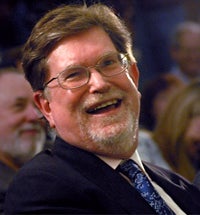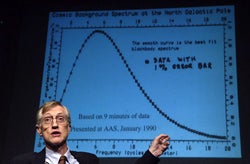Two American cosmologists will take home the 2006 Nobel prize in physics, the Royal Swedish Academy of Sciences announced Tuesday. George Smoot of Lawrence Berkeley National Laboratory in Berkeley, California, and John Mather of NASA’s Goddard Space Flight Center in Greenbelt, Maryland, will split the $1.4 million prize.
Both scientists were instrumental in the success of NASA’s Cosmic Background Explorer. Launched in 1989 after a decade of development, the satellite was the first to detect faint temperature variations in the cosmic microwave background (CMB), the remnant radiation representing the first light able to move freely through the universe after the Big Bang. “I think of it as the accumulated trace of everything,” says Mather, who is now a senior scientist for NASA’s James Webb Space Telescope.
COBE’s all-sky map of these temperature variations has been called astronomers’ first “baby picture” of our universe. “It’s like looking at an embryo that’s a few hours old,” says Smoot.
In January 1990, when the COBE team presented its measurement of the universe’s average temperature at an American Astronomical Society meeting, the match between theory and data was so good, the assembled scientists audibly gasped. The data points fell perfectly in line with a theoretical thermal spectrum called a blackbody.
The match “says that the radiation really did come from the Big Bang,” Mather explains. “There really is not a good alternative explanation for having such a perfect blackbody spectrum.”
COBE was slated to be launched by the space shuttle, but the 1986 Challenger disaster kept it grounded. “We not only had to wait to get into space, we actually had to improve,” says Smoot, who during the delay lobbied NASA for additional funds to make the satellite’s instruments more sensitive.
In addition to detecting miniscule CMB temperature differences, COBE had to do so against the roaring emission from our galaxy and others. The scientists also had to compensate for the Doppler shift caused by Earth’s motion around the Sun, the Sun’s orbit through the Milky Way, and the Milky Way’s drift within the local cluster of galaxies.
The groundbreaking effort paved the way for still-more-precise measurements taken with NASA’s Wilkinson Microwave Anisotropy Probe (WMAP), which determined the CMB was emitted 380,000 years after the Big Bang. It also pegged the universe’s age at 13.7 billion years. The European Space Agency’s Planck mission, set to launch next year, is expected to sharpen scientists’ view of the CMB still further.
“One of the continuing investigations is to get the polarization of this radiation,” Mather says. WMAP has already measured polarization changes that occurred after the CMB, when the first stars formed. “Much more is thought to be lurking there in the radiation if we could measure even better.”











